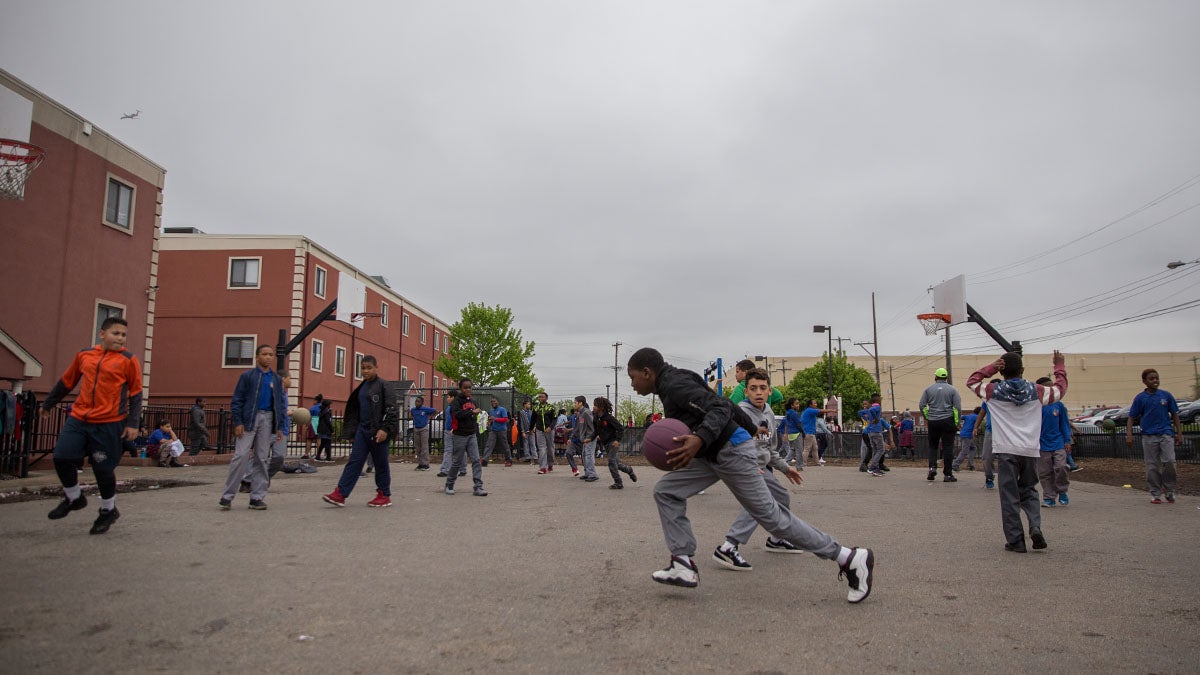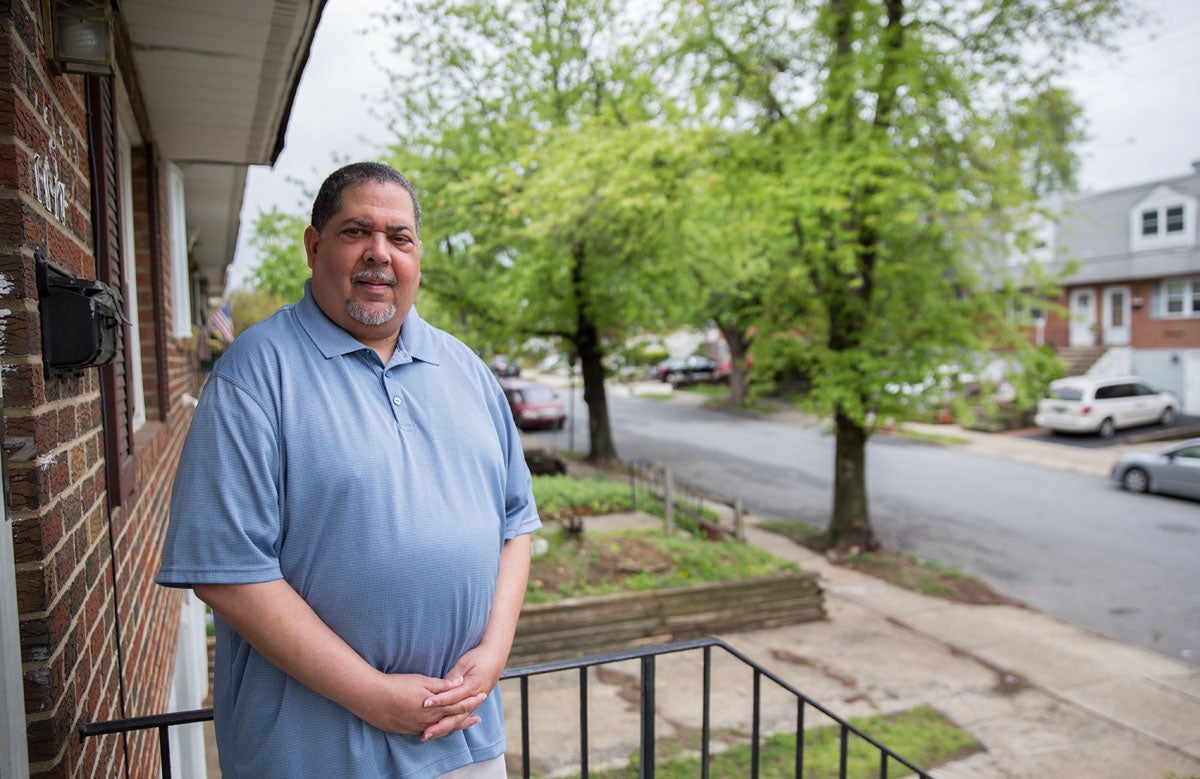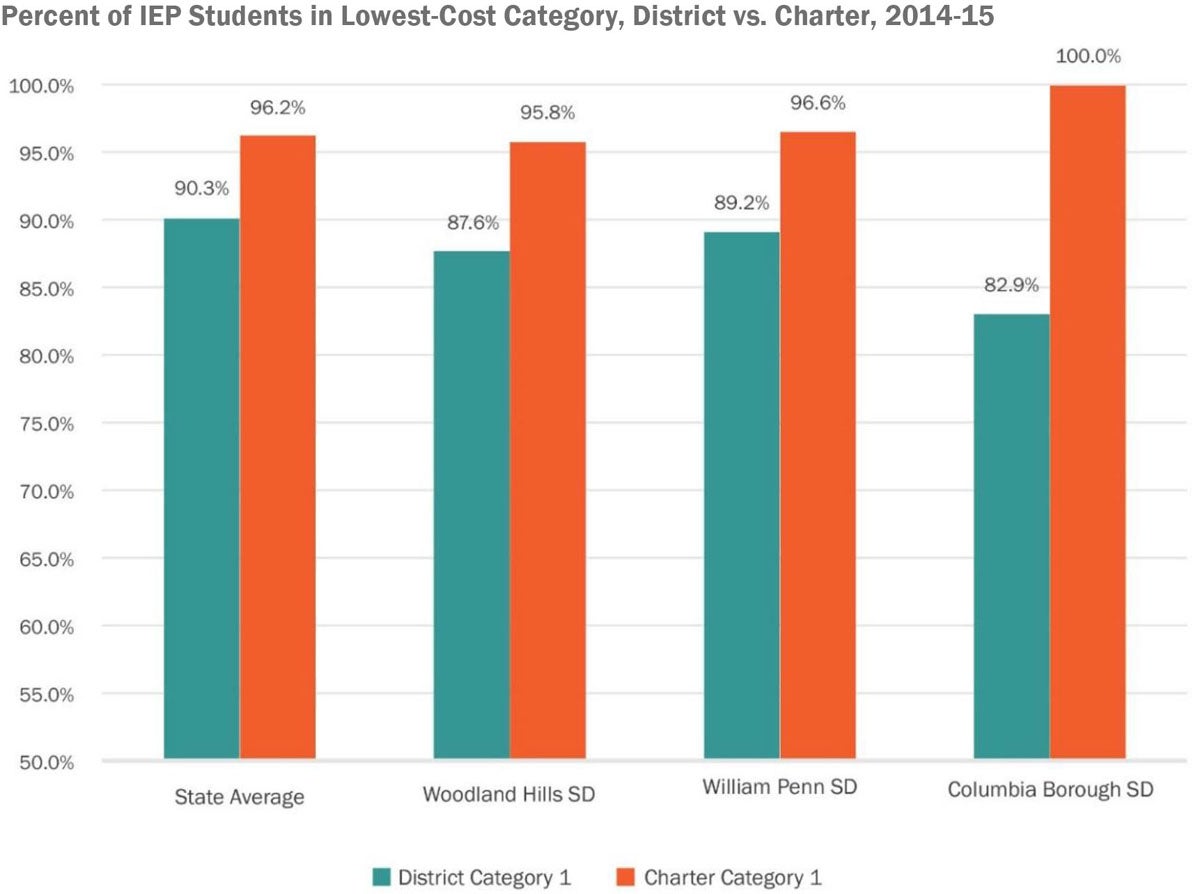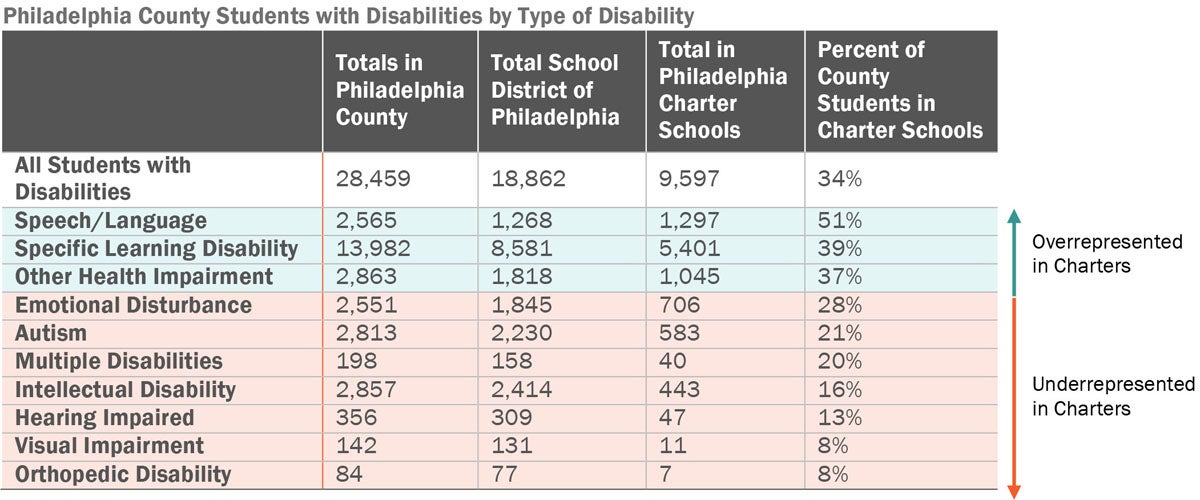Quirk in Pa. charter law cripples traditional districts while giving charters ‘cash cow’

Students from Chester Community Charter School play basketball during recess in Chester, Pennsylvania. (Lindsay Lazarski/WHYY)
The district is pinning its hopes on an unusual strategy: bringing special education students back to district schools from charters.
When Delaware County’s Chester Upland School District raised taxes last summer for the fourth year in a row, it was just the latest move in a long-running attempt to bring a chronically deficit-ridden district back to financial health.
“We keep asking the state to give us more,” said Chester Upland’s school board president, Anthony Johnson. “And the board’s mindset is, we’ve got to stand up and do for self, too.”
The district is pinning its hopes on an unusual strategy: bringing special education students back to district schools from charters — a move that could cut the district’s $7 million dollar deficit by almost a third.
“This year we’re coming after the cyber [charter] children. If we can get 50 back, that’s over $2 million,” Johnson said. “That’s revenue. You have to look at it as revenue.”
In the tangled world of Pennsylvania public school financing, special education payments to charters are a particularly thorny problem.
The payments are not calculated based on the actual cost of services, which can vary widely depending on a given student’s needs. Nor are they based on the actual number of students served.
Instead, payments are calculated by a bafflingly complex formula that treats all districts and disabilities equally. The results can seem absurd, but bust budgets nonetheless.
Chester Upland spends about $16,000 a year on average for each special ed student in its traditional district schools. But the state’s formula has forced it to pay more than $40,000 per student to charters, regardless of the child’s level of disability.
Those payments crippled Chester Upland so badly that Gov. Tom Wolf and the courts stepped in.
But this is far from just an issue in Chester Upland. Newly analyzed state data show that a combination of quirks in the charter law have caused a statewide problem, because charters across Pennsylvania are enrolling a greater share of the least needy, least costly special ed students.
The special ed funding formula’s intricacies are infamous. But the problem in a nutshell is this: when the neediest students concentrate in district schools, that drives up the per-pupil payments that districts must pay charters.
It’s a paradox that can drain the budgets of traditional school districts while infusing charters with cash. And it creates incentives for districts like Chester Upland to do what they can to keep special ed students from migrating to charters and cyber-charters.
That’s a strategy that has the support of Chester resident Jean Arnold, a longtime education advocate in the city.
“Let’s specifically go after some of those children who are costing us so much money, so our efforts will get more bang for the buck,” she told Johnson after Chester Upland’s latest tax was passed. “Let’s put together a real strategic plan.”
Arnold, though, acknowledges that she doesn’t like seeing the district and its charters competing for students just to keep their respective budgets balanced.
“I hate to hear someone say, ‘we need to bring students here because our revenues are down,'” Arnold said. “I would like to hear them say, ‘we’re doing … a great job preparing our students.'”
 Anthony Johnson is the board president of the Chester Upland School District. (Lindsay Lazarski/WHYY)
Anthony Johnson is the board president of the Chester Upland School District. (Lindsay Lazarski/WHYY)
‘Cash cow’
Chester Upland is not the only district to face surprisingly high special ed payments, but no district in the state has seen them batter its budget so badly.
Wolf’s 2015 intervention brought them under control, but despite years of attempts in Harrisburg at broader reform, the status quo remains stubbornly in place for the rest of Pennsylvania.
“The court can’t intervene in 500 districts,” said Jeff Ammerman of the Pennsylvania State Association of School Business Officials.
The Pa. House of Representatives passed a bill this week that would revise the state’s 20-year-old charter school law. The changes are being hotly debated as it moves to the Senate for consideration.
The bill, though, does not address this issue.
Among the biggest obstacles to this reform is the fact that charters are not required to spend special ed payments on special ed students. For better or worse, the payments have evolved into a kind of hidden subsidy on which schools have come to depend.
“I call it a cash cow for the charter and cyber schools,” said Rep. Bernie O’Neill, R-Bucks, a former special ed teacher. “My god, don’t tell me that it’s costing you $42,000 to educate any kind of student. I’m sorry. I’m sorry! You can go to Villanova for that kind of money!”
O’Neill has long been one of the system’s staunchest critics. In 2013, he was a part of a bipartisan commission that called for major system-wide changes, only to see lawmakers leave the status quo almost entirely untouched.
“Special ed money should be going to kids with disabilities,” O’Neill said. “If they’re using the money for other kids … there’s something wrong with their business plans. And they’re hurting the local districts and their students.”
Charter advocates defend the payments, saying that they make up for shortfalls in other areas.
“The funding has always been designed to go into a pool to provide for all students in a school,” said Max Tribble, a spokesman for Chester Community Charter School.
Susan Spicka, executive director of Education Voters of Pennsylvania, a group that is part of a coalition pushing to revise the formula, says the high payments reflect a “clearly broken” system that can hurt charters and district budgets alike.
“Everything is out of whack,” said Spicka, who is trying to build a coalition of support to reform this part of the law. “There’s no way that this was the intent of legislators.”
Inaccurate assumptions and inflated payments
Pennsylvania’s formula for distributing special education funds is built on two major assumptions. One is that all districts serve the same percentage of special education students — 16 percent. The other is that high-cost and low-cost special ed students are equally distributed in charters and district schools.
Neither assumption is consistently accurate, meaning districts don’t necessarily get a fair share of special education funding from the state, and charters don’t necessarily get a fair share from their districts.
In theory, analysts say, the system can shortchange both charters and districts — and benefit either, too.
Districts with low levels of special ed students can end up with more state funding than their actual numbers might call for. And charters can find themselves “underpaid for students who require more intensive services,” said Spicka.
But the system does particular damage to high-poverty districts like Chester Upland, Philadelphia and others that have large numbers of special education students with high needs.
Such districts get less than they might need to begin with, and then the state’s convoluted formula inflates their required payments to charters.
The result drains district budgets and gives charters a surplus that they can spend however they wish.
Pennsylvania Association of School Business Officials’ 2014 analysis of the system estimated that charters were paid about $350 million for special ed services, but spent only about $150 million on those services — resulting in what PASBO called a “nearly $200 million profit at the expense of school districts and local taxpayers.”
This year, during the debate on potential changes to the state charter law, Rep. Mike Sturla, D-Lancaster, claimed that the overpayment could be as much as $300 million a year.
A recent analysis by the Education Law Center found the current special ed funding system creates “a perverse incentive” for charter schools to maximize enrollment of low-cost special ed students — such as those needing speech therapy — and avoid enrolling those with high-cost needs, such as those with autism, which could require tens of thousands of dollars worth of specialized services.
Chester Upland became the poster child for the crippling effects of this system. Its deficit grew so large that, in 2015, following Wolf and the courts’ intervention, Chester’s brick-and-mortar charters agreed to accept a payment more in line with state averages — about $27,000.
The worst of the crisis was averted, but the district’s deficit remains.
And while Chester Upland is particularly vulnerable, the rise of cyber-charters means that even small or rural districts can find themselves on the hook for large and unexpected bills.
“If in a particular year you have two or three more [students] leave than anticipated, that’s not an insignificant amount of money,” PASBO’s Ammerman said. “That’s over $100,000.”
‘Commonwealth triple-screw’
At the root of the formula’s inequities is the 16 percent assumption. This percentage drives both the amount districts receive from the state, and the per-pupil “tuition” districts must pay charters.
This means that any district serving a larger share of special ed students is effectively shortchanged from the start. “The grandfathered system … treats them as serving fewer students in need of special education than they actually serve,” a new study from Research For Action concluded.
The 16 percent figure skews things a second time when it is used — in combination with a district’s actual expenses — to calculate what charters get paid per pupil.
RFA’s study looked at three school districts spread across the state — William Penn in Delaware County, Woodland Hills in Allegheny County, and Columbia Borough in Lancaster County — and found that, in each, charters’ per-pupil payments are artificially inflated by the assumptions in the state’s math:
William Penn actually spends about $15,700 per special ed student, representing 19 percent of its total student enrollment. But calculations assuming that it provides services to only 16 percent of its students generate a charter payment of $18,500.
Woodland Hills actually spends $13,500 per special ed student, representing 25 percent of enrollment. Calculations assuming 16 percent generate a charter payment of $20,800.
Columbia Borough actually spends $12,500 per special ed student, representing 25 percent of enrollment; calculations assuming 16 percent generate charter payments of $19,900.
Finally, a third factor tends to inflate payments: the fact that students needing costlier services tend to concentrate in schools run by traditional districts, not charters.
This too drives up districts’ per-pupil spending, and thus the amount to which charters are entitled. Paradoxically, the more high-cost students a district retains, the more it must pay its charters.
Previous analyses of this issue have relied on Philadelphia data to make this point. RFA’s new research provides backing for what has long been assumed: this is a statewide issue.
As the graph below shows, charters are enrolling more students with individualized education plans (the marker of special ed status) that are less costly to meet.
 Graphic by Research for Action
Graphic by Research for Action
At the same time, on the whole, traditional district schools enroll a greater share of high needs, high cost students than charters.
Across Pennsylvania, about 10 percent of special ed students in district schools are considered high-cost. The share in charter schools is only about 4 percent.
In Philadelphia, RFA found that charters serve about a third of the city’s special-ed population, which is in line with its total share of city students.
But Philadelphia charters serve a disproportionately higher share of the least costly students (41 percent) and a disproportionately lower share of those with the most costly needs (7 percent).
 Graphic by Research for Action
Graphic by Research for Action
A previous study by the Education Law Center came to a similar conclusion.
“The disparity is clear,” ELC wrote. “Charter schools in Philadelphia are serving far fewer students with the most severe disabilities, in favor of students with disabilities requiring low cost services.”
The new RFA report shows that this dynamic is also present in William Penn, Woodland Hills and Columbia Borough.
in Woodland Hills, 12 percent of its special ed students are high-cost; in its charters, about 4 percent;
in William Penn, 11 percent are high-cost, in its charters, about 3 percent;
in Columbia Borough, about 17 percent of district students are high-cost, in its charters, none are.
Combined, these multiple factors — the insufficient initial outlay, the often-inaccurate 16 percent assumption driving per-pupil payment calculations, and the tendency of high-cost students to stay in district schools, not charters — make up what Bruce Baker of Rutgers University memorably dubbed the “Commonwealth Triple Screw … one of the least fair, least logical approaches to special education funding.”
And, as Spicka reiterates, it’s not just districts that end up on the short end of the financial stick.
“The charter schools that want to do the right thing [have a] disincentive to take on a high-cost kid,” Spicka said. “They might not receive enough funding.”
Reforms fail; Chester persists
Pennsylvania’s last major effort to update the system dates to 2013, when a special education funding commission recommended a major reworking of the state formula.
The legislature eventually passed a reform bill which created three cost categories — the relatively low-cost category one, and the higher-cost categories two and three.
But in part due to lobbying by the charter sector, the new calculations apply to only a tiny sliver of newly-appropriated funding — just about $20 million out of about a billion dollars of state special ed spending. Last year, O’Neill introduced legislation to expand the use of the formula, but it died.
That means for the foreseeable future, many school districts across the state will continue to be put at a disadvantage based on state policy.
And especially hard-hit districts like Chester Upland will be left to face some very tough decisions.
Chester Upland’s current deficit remains close to $7 million dollars, and next year’s could be twice that. This year’s comparatively modest tax increase — just about $30 per household — was nowhere near what was needed. So far, the effort to lure back special ed cyber students, launched last summer, hasn’t proven effective. “We started too late,” said Anthony Johnson, the board president.
And while its special ed payments to brick-and-mortar charters have been reduced, Chester Upland is still paying its cyber charters upwards of $40,000 per special ed student — a fact which doesn’t make Chester Community Charter School happy.
“I don’t think that is fair,” spokesman Max Tribble said. “We made cuts in order to have a fair agreement with the district. The cybers didn’t.”
Tribble is confident that CCCS can continue providing quality services even with the reduced payments. Anthony Johnson is optimistic that next year’s effort to bring back cyber charter students will be more successful.
And Chester resident Jean Arnold hopes to eventually hear less about the financial bottom line, and more about the overall quality of instruction.
“Most of the people to whom I speak want the best for our children,” she said. “We realize we have deficits. But when all of the dust settles the reason we are here is because we have to develop our young people. Let us keep our eye on the prize.”
Save
Save
Save
Save
Save
Save
Save
Save
Save
Save
Save
Save
Save
Save
WHYY is your source for fact-based, in-depth journalism and information. As a nonprofit organization, we rely on financial support from readers like you. Please give today.


